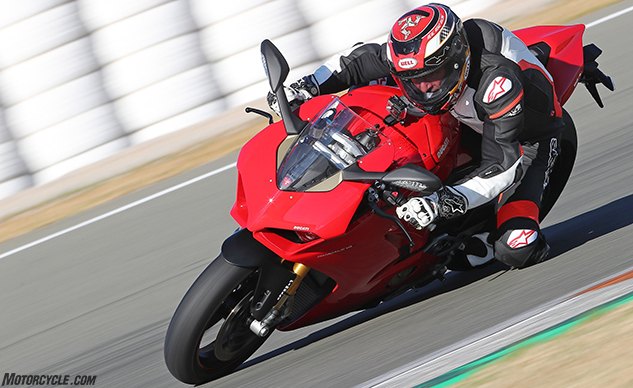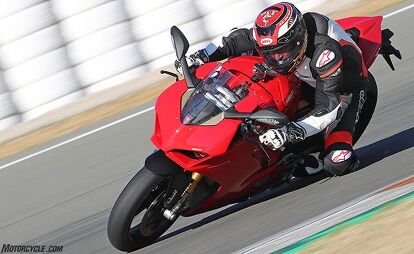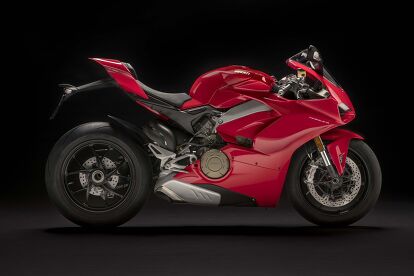2018 Ducati Panigale V4 First Ride Review: 10 Things You Need To Know
Game-changing performance and technology
We just returned from the launch of Ducati’s all-new Panigale V4, and it’s no exaggeration to describe it as one of the best sportbikes ever made, perhaps even the best. Its new four-cylinder engine is melodious and powerful, it handles with agility akin to a much smaller bike, its electronics are leading-edge and fully customizable, and it looks sensational in person.
2018 Ducati Panigale V4
| Engine | 20/20 |
| Suspension/Handling | 15/15 |
| Transmission/Clutch | 9.5/10 |
| Brakes | 10/10 |
| Instruments/Controls | 5.0/5 |
| Ergonomics/Comfort | 8.0/10 |
| Appearance/Quality | 9.0/10 |
| Desirability | 9.5/10 |
| Value | 7.5/10 |
| Overall Score | 93.5/100 |
All Things Ducati on Motorcycle.com
Ducati says the Panigale V4 is the biggest investment the company has ever made in a single product, four years in development, and that claim is perfectly believable after riding the bike at the Ricardo Tormo circuit in Spain. Here, in bite-sized chunks, is why its technology and performance will take the superbike class by storm. Don’t be surprised if it takes top honors in sportbike shootouts around the world in 2018.
Get the Flash Player to see this player.
1. Ultra Performance
Perhaps you might think I’m just a victim of drinking Ducati Kool-aid after a fun trip to Spain, but doubting Thomases should be persuaded by lap times. The fastest race lap aboard a Ducati MotoGP racebike during the 2017 Valencia GP was Andrea Dovizioso clocking a 1:31.78. Alessandro Valia, Ducati’s development rider, lapped 5 scant seconds slower (1:36.84) aboard the Panigale V4 streetbike!
Keep in mind that Valia, although rippin’ fast, isn’t in the same league, literally, as GP-winner Dovi. Also, this is on a production bike with headlights and other street equipment, even if it was fitted with the accessory Akrapovic exhaust and Pirelli SC1 Superbike slicks.
To illustrate how fast the Panigale V4 can burn up a GP track, take a look at the video below. Also take note of how frequently the amber light on the top-left portion of the instruments illuminates to indicate traction-control interventions. Then tell us again how you believe a rider can go quicker without “nannying” electronic aids.
2. Engine-eering
Ducati pushed its engineering and marketing efforts to the limits with this new Stradale V4 motor. It required considerable cojones to abandon its legacy of V-Twin engines in favor of a MotoGP-inspired V-4 powerplant. Common to both Ducatis (GP and Stradale) is the 90-degree V-4 engine arrangement and “Twin Pulse” firing order, in which the two left-side cylinders and two right-side ones fire closely together. Even seasoned ears can be fooled into thinking the Stradale V4 sounds at idle like a typical Duc Twin. But letting the potent motor climb up to its 14,500-rpm redline reveals a roaring howl that is a near duplicate of Ducati’s MotoGP machine, supplanting the signature V-Twin boom that has been a hallmark of the Italian brand since superbike racing was created.
3. Engine Room
Also shared is the engines’ 81mm bore size, but the Stradale V4 uses a longer stroke (53.5mm) that yields a total displacement of 1103cc. Yes, it’s a cheater motor in the literbike class. (A 999cc R version is on deck for the 2019 season to fit Superbike racing regulations.)
So, it should be no surprise that Ducati’s claim of 214 crankshaft horsepower is greater than any of the class’ 1000cc competitors, including the 199-hp stated by BMW for the S1000RR and the 1299’s 197 ponies. The big motor’s 91.1 lb-ft of torque at 10,000 rpm claim also vanquishes any literbike. Trackday enthusiasts will want to opt for the titanium Akrapovic accessory exhaust system, which sounds awesome and boosts power by 12 horses to a mad 226.
The S-V4 tore around the Valencia circuit with a ferocious vigor, piling on speed at a pace similar to the lightweight carbon-framed BMW HP4 Race I rode a few months ago, which claimed a similar peak hp figure of 215 ponies. The Duc perhaps has a smoother powerband, thanks to its extra displacement and employment of variable-length throttle body intakes. Despite the high output, valve-inspection intervals are suggested at a reasonable 15,000 miles.
4. Going Backward To Move Forward
The new engine also employs the relatively novel trick of the MotoGP Desmosedici’s reverse-rotating crankshaft, which offsets some of an engine’s negative gyroscopic effect on steering responses. This is an arrangement used in Ducati’s GP bikes since 2010, and its effectiveness of providing beneficial agility is veritable because all other MotoGP teams use it – despite sapping 1% of power. That’s because a jackshaft is required for reversing rotation again to the countershaft sprocket.
The effectiveness of this arrangement was readily apparent when riding around Valencia, as the Panigale V4 tipped into corners with the ease of a much smaller-engined sportbike. It exhibits a friendly neutral balance and is easier to ride than the more finicky 1299. It’s both willing and cooperative.
5. Weight-less
Losing weight isn’t just difficult for humans, but Ducati has pared ounces wherever possible. Its monocoque frame design uses the engine as a stressed member in accompaniment with an aluminum front section that incorporates the steering head. It’s said to scale in at just 9.2 lbs, which is 8 lbs lighter than the exotic carbon-fiber full frame on the HP4 Race. Its single-sided aluminum swingarm is 76mm longer than the 1299’s for better traction, but weighs the same 11.2 lbs. To gain perspective on the relative weights of these structural pieces, consider the Panigale V4’s exhaust system: at 21.4 lbs, it weighs more than the frame and swingarm combined.
Aluminum, rather than heavier steel, is used for the Panigale’s fuel tank, a portion of which is positioned below the rider MotoGP style. Its total capacity is 4.23 gallons. The curb weight for the V4 S is stated at 430 lbs, 6 lbs lighter than the standard Panigale V4 because of its lighter wheels and lithium-ion battery.
6. Hi, Tech!
The Panigale V4’s electronics are state of the art, employing a new six-axis Bosch IMU to provide a host of aids that keep riders safer while helping them go faster. Most are evolutions of existing aids, but there are a few new ones like slide control, drift braking and lean-angle sensitive quickshifting (up and down) and engine-brake control. All are independently adjustable via intuitive left-side switchgear and visible on the brilliant TFT instrument panel.
- ABS Cornering Bosch EVO
- Ducati Traction Control EVO (with “spin on demand” when set to levels 1 or 2)
- Ducati Slide Control (DSC)
- Ducati Wheelie Control EVO
- Ducati Power Launch (DPL)
- Ducati Quick Shift up/down EVO
- Engine Brake Control EVO
- Ducati Electronic Suspension EVO (on V4 S and Speciale models)
After fettling with various settings, I preferred ABS 1 (ABS on front wheel only), DTC 3 (allowing controllable sliding), and DWC 2 (because I like wheelies). I didn’t have time to experiment with EBC. The quickshifter swapped cogs up and down as seamlessly as any gearbox I’ve toggled.
7. Suspenders
The standard Panigale V4 uses a fully adjustable Showa Big Piston fork and Sachs shock, while the V4 S we tested employs the latest generation of Öhlins semi-active suspension in an NIX-30 fork and TTX36 shock. Manual mode allows compression, rebound, and steering damper settings to be manually set, while the dynamic mode automatically adjusts damping depending on various parameters received from the IMU.
I wasn’t a big proponent of the first-gen Öhlins electronic suspension on the 1299 Panigale, so I’m happy to report that the Öhlins Smart EC 2.0 system proved faultless under my butt at Valencia. Its dynamic mode features Objective Based Tuning Interface (OBTi), which provided well-chosen damping rates at all points around the track. Ride modes affect the tuning, providing a plusher stroke in Street mode than the stiffer setups in and Sport and Race modes. After the first session, I switched to Race mode and didn’t have a suspension complaint the rest of the day.
8. Braking Benchmarks
At Valencia, I was initially disappointed with the Stylemas’ softer bite, but after a few laps I dug into their deep well of power, and found they actually delivered superior modulation thanks to a longer lever pull. There ain’t nothing wrong with M50s, but these new calipers are at least as good and combine for a loss of 140 grams from the front wheel. At the rear, a two-piston clamper squeezes a 245mm rotor.
9. Don’t Worry, Be IP
Traditionalists are often scornful of electronic instrument panels, but there’s lot to love about the Panigale V4’s 5-inch high-brightness TFT display, which might be the best one we’ve ever seen. Old-school riders will appreciate the analog tachometer whose needle changes from white to orange to red as the engine approaches its rev limit. The panel also includes a trip computer, air temp gauge, lap timer, clock and Ducati Multimedia System information. Its electronics even boasts self-canceling turnsignals, although I hope you’ll forgive me for not testing them at Valencia.
Importantly, a rider doesn’t need to memorize the owner’s manual to be able to navigate the various controls and setting. Ducati tells us it worked closely with parent company Audi to simplify the instrument’s controls and menu settings to make the IP intuitive, and those efforts have paid off. It requires just a few minutes of poking around the switchgear (borrowed from the Multistrada) to execute and adjust various settings.
10. Price-y
You didn’t think all this technology and Italian craftsmanship would be cheap, did you? The Panigale V4 S we tested retails for a healthy $27,495. That’s a lot, but it’s a whole lotta sport motorcycle. Riders on a budget might prefer the base model, which rings in $6,300 cheaper at a more palatable $21,195.
In case it’s not yet obvious, let me state unequivocally that the Panigale V4 S is the best sportbike you can buy for less than $28,000. It’s packed with performance and technology that shames anything else in its price range, and the fact that its lovely Italian styling adds a certain panache is the cherry on top. It simply sets a new standard for sportbikes.
2018 Ducati Panigale V4
+ Highs
- Incredibly high performance
- The agility of a 750
- Class-leading instruments and rider aids
– Sighs
- Some cars are cheaper
- Sidestand nearly impossible to deploy with race boots
- Ambitious muffler tuning dulls MotoGP soundtrack
2018 Ducati Panigale V4 Specifications | |||
|---|---|---|---|
Panigale V4 | Ducati Panigale V4 S | Ducati Panigale V4 Speciale | |
| Engine Type | Desmosedici Stradale 90° V4, rearward-rotating crankshaft, 4 Desmodromically actuated valves per cylinder, liquid cooled | ||
| Displacement | 1,103 cc | ||
| Bore x Stroke | 81 mm x 53.5 mm | ||
| Compression ratio | 14.0:1 | ||
| Power | 157.5 kW (214 hp) @ 13,000 rpm (claimed) | ||
| Torque | 124.0 Nm (91.5 lb-ft) @ 10,000 rpm (claimed) | ||
| Fuel injection | Electronic fuel injection system. Twin injectors per cylinder. Full ride-by-wire elliptical throttle bodies. Variable length intake system | ||
| Exhaust | 4-2-1-2 system, with 2 catalytic converters and 2 lambda probes | ||
| Gearbox | 6 speed with Ducati Quick Shift (DQS) up/down EVO | ||
| Primary Drive | Straight cut gears; Ratio 1.80:1 | ||
| Gear Ratios | 1=38/14 2=36/17 3=33/19 4=32/21 5=30/22 6=30/24 | ||
| Final drive | Chain; Front sprocket 16; Rear sprocket 41 | ||
| Clutch | Hydraulically controlled slipper and self-servo wet multiplate clutch | ||
| Frame | Aluminum alloy “Front Frame” | ||
| Front Suspension | Fully adjustable Showa BPF fork. 43 mm chromed inner tubes | Öhlins NIX30 43 mm fully adjustable fork with TiN treatment. Electronic compression and rebound damping adjustment with Öhlins Smart EC 2.0 event-based mode | Öhlins NIX30 43 mm fully adjustable fork with TiN treatment. Electronic compression and rebound damping adjustment with Öhlins Smart EC 2.0 event-based mode |
| Front Wheel | 5-spokes light alloy 3.50″ x 17″ | 3-spokes forged aluminum alloy 3.50″ x 17″ | 3-spokes forged aluminum alloy 3.50″ x 17″ |
| Front Tire | Pirelli Diablo Supercorsa SP 120/70 ZR17 | ||
| Rear Suspension | Fully adjustable Sachs unit. Aluminum single-sided swingarm | Fully adjustable Ohlins TTX36 unit. Electronic compression and rebound damping adjustment with Öhlins Smart EC 2.0 event-based mode. Aluminum single-sided swingarm | Fully adjustable Ohlins TTX36 unit. Electronic compression and rebound damping adjustment with Öhlins Smart EC 2.0 event-based mode. Aluminum single-sided swingarm |
| Rear Wheel | 5-spokes light alloy 6.00” x 17” | 3-spokes forged aluminum alloy 6.00″ x 17″ | 3-spokes forged aluminum alloy 6.00″ x 17″ |
| Rear Tire | Pirelli Diablo Supercorsa SP 200/60 ZR17 | ||
| Wheel travel (front/rear) | 120 mm (4.7 in) – 130 mm (5.1 in) | ||
| Front brake | 2 x 330 mm semi-floating discs, radially mounted Brembo Monobloc Stylema (M4.30) 4-piston callipers with Bosch Cornering ABS EVO | ||
| Rear brake | 245 mm disc, 2-piston calliper with Bosch Cornering ABS EVO | ||
| Instrumentation | 5″ TFT colour display | ||
| Dry weight | 386 lb (claimed) | 384 lb (claimed) | 384 lb (claimed) |
| Kerb weight | 436 lb (claimed) | 430 lb (claimed) | 430 lb (claimed) |
| Seat height | 830 mm (32.48 in) | ||
| Wheelbase | 1.469 mm (57,8 in) | ||
| Rake | 24.5° | ||
| Front Wheel trail | 100 mm (4 in) | ||
| Fuel tank capacity | 16 l – 4.23 gallon | ||
| Number of seats | Dual seats | Dual seats | Single seat |
| Electronics | Riding Modes, Power Modes, Bosch Cornering ABS EVO, Ducati Traction Control (DTC) EVO, Ducati Wheelie Control (DWC) EVO, Ducati Slide Control (DSC), Engine Brake Control (EBC) EVO, Auto Tire calibration | ||
| Standard Equipment | Ducati Power Launch (DPL), Ducati Quick Shift (DQS) up/down EVO, Full LED lighting with Daytime Running Light (DRL), Sachs steering damper, Quick adjustment buttons, Auto-off indicators | Ducati Power Launch (DPL), Ducati Quick Shift (DQS) up/down EVO, Full LED lighting with Daytime Running Light (DRL), Ducati Electronic Suspension (DES) EVO with Ohlins suspension and steering damper, Quick adjustment buttons, Lithium-ion battery, Auto-off indicators, Marchesini aluminum forged Wheels | Ducati Power Launch (DPL), Ducati Quick Shift (DQS) up/down EVO, Full LED lighting with Daytime Running Light (DRL), Ducati Electronic Suspension (DES) EVO with Ohlins suspension and steering damper, Quick adjustment buttons, Lithium-ion battery, Auto-off indicators, Marchesini aluminum forged Wheels, Carbon fibre front/rear mudguards, Machined-from-solid top yoke with identification number, Alcantara seat, Dedicated handle grips, Adjustable foot pegs, Carbon fiber heel guard, Carbon fiber cover swinging arm, Racing articulated levers, Racing fuel tank cap, Brake level protection |
| Additional Equipment | Passenger seat and footpegs kit | Passenger seat and footpegs kit | Ducati Performance by Akrapovic Titanium full-racing exhaust system, Racing windshield, Machined mirror block-off plates, License plate mount removal plug, Ducati Data Analyser+ (DDA+) with GPS module, Paddock bike cover |
More by Kevin Duke































































































































Comments
Join the conversation
Excuse me, I got to take a cold shower.
No mention of the HP4 Race service interval? Lame. Ducati destroys the competition with this bike.